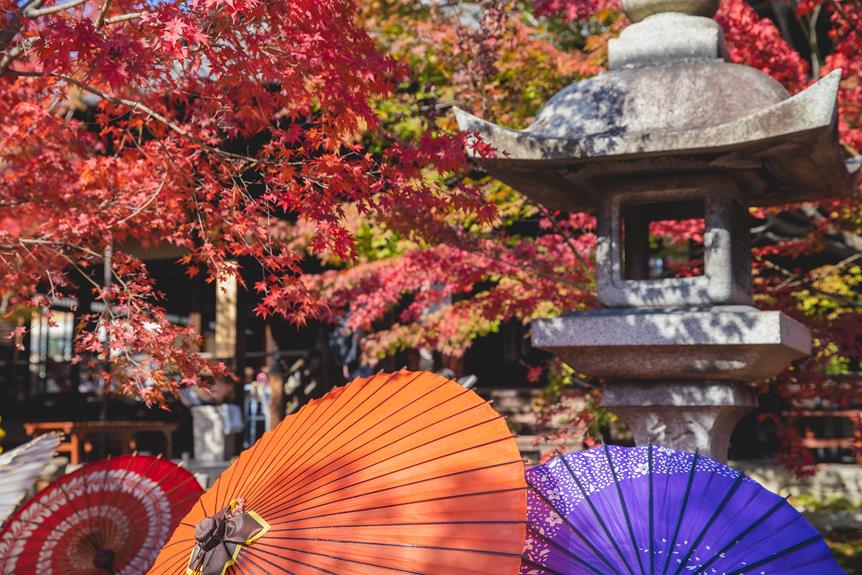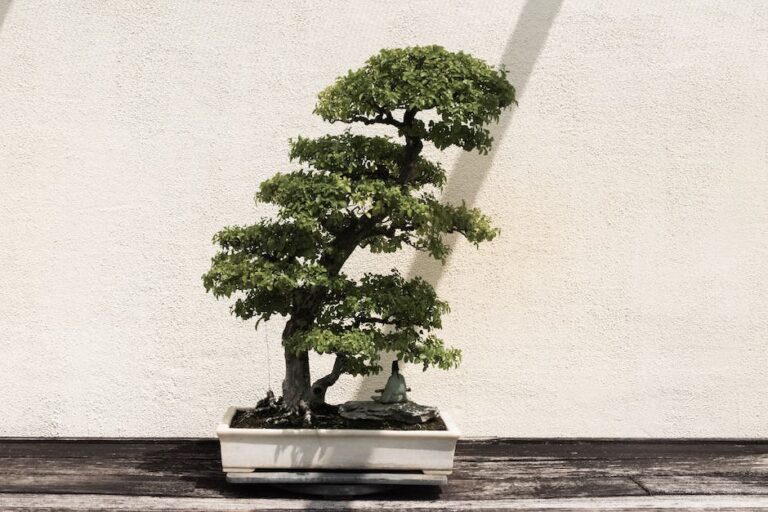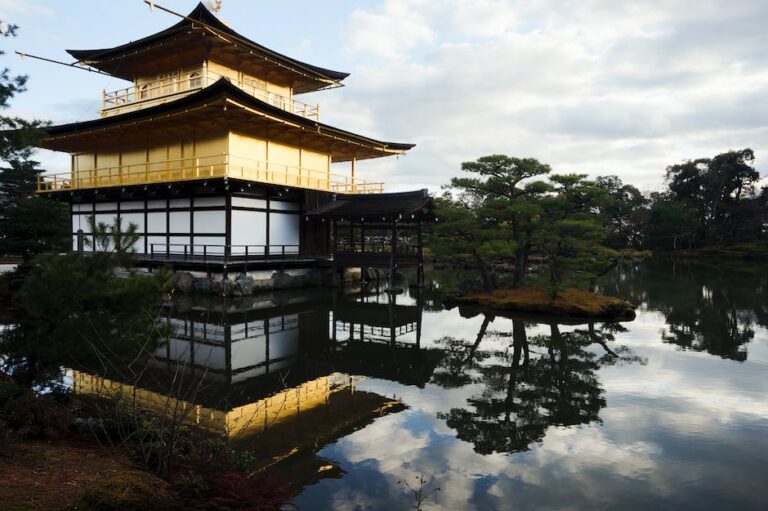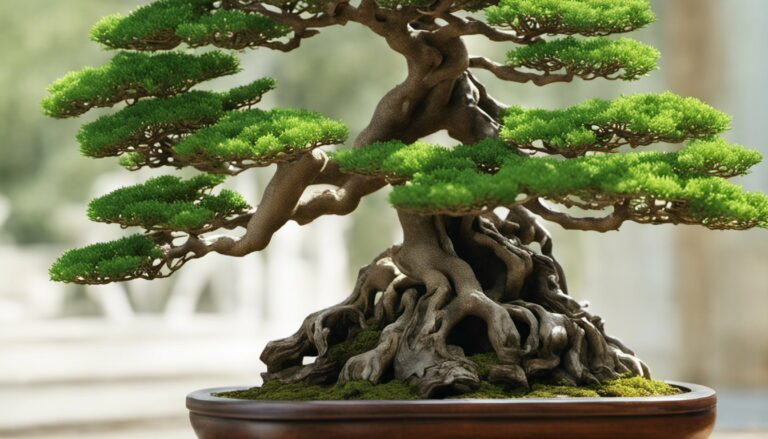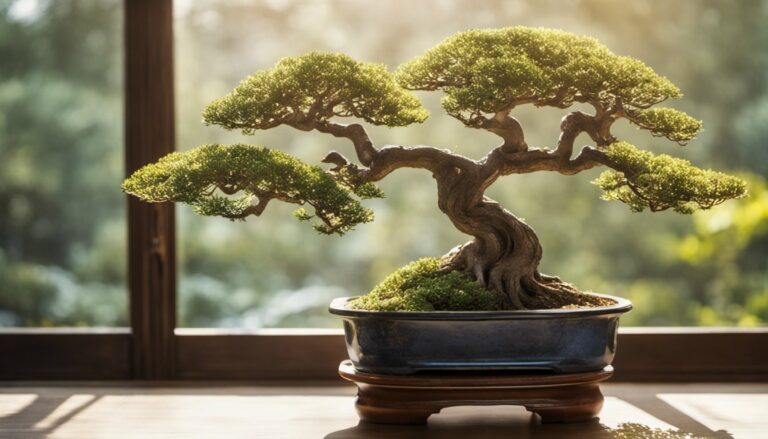Indoor Care for Japanese Maple Bonsai
As an ardent lover of Japanese Maple Bonsai, I believe that nurturing these delicate beauties indoors is a unique and rewarding journey.
In my view, the art of indoor care requires a delicate touch and a deep connection with these miniature marvels. It’s clear to me that the right balance of light, humidity, and attention can transform your indoor space into a haven for these graceful trees.
In this article, I’ll share my insights on the art of indoor care for Japanese Maple Bonsai, offering tips and personal experiences to help you embark on this fulfilling endeavor.
Robins Thoughts
- Choose a location with adequate sunlight and protection from extreme temperatures
- Water the bonsai when the top inch of soil feels slightly dry
- Fertilize every two weeks during the growing season with a balanced, slow-release organic fertilizer
- Regularly inspect the bonsai for signs of pests and diseases and take preventive measures
Choosing the Right Location
To ensure the health of your Japanese maple bonsai, you’ll want to find a location that provides adequate sunlight and protection from extreme temperatures. Choosing the right location is crucial for the well-being of your bonsai.
Japanese maples thrive in bright, indirect sunlight, so it’s important to place your bonsai near a window that receives ample light. However, be cautious of direct sunlight, as it can scorch the delicate leaves.
Additionally, maintaining the right temperature is vital. Japanese maples prefer cooler temperatures between 60-75°F (15-24°C). Avoid placing your bonsai near drafty windows or heating vents, as extreme temperature fluctuations can stress the plant.
Find a spot in your home that offers a stable, moderate temperature, ensuring your Japanese maple bonsai remains healthy and vibrant.
Providing the Ideal Lighting Conditions
Make sure you’re giving your bonsai the right amount of light to keep it healthy and thriving. Proper lighting is crucial for the growth and development of your Japanese maple bonsai. Here are some tips to help you provide the ideal lighting conditions:
- Natural Lighting Alternatives:
- Place your bonsai near a south-facing window to maximize exposure to sunlight.
- If natural light is limited, consider using a grow light specifically designed for bonsai trees.
- Rotate your bonsai regularly to ensure all sides receive equal light.
- Types of Artificial Lighting:
- LED grow lights are energy-efficient and provide a balanced spectrum of light for optimal growth.
- Fluorescent lights are affordable and work well for most bonsai species.
- High-intensity discharge (HID) lights are the most powerful and suitable for large bonsai collections.
Remember to monitor your bonsai’s response to the lighting conditions and make adjustments as needed. Providing the right amount and type of light will promote healthy foliage and vibrant growth in your Japanese maple bonsai.
Watering and Humidity Requirements
Ensure you maintain the proper watering schedule and humidity levels for your bonsai tree to promote its health and vitality.
Bonsai trees have specific watering needs that must be met to ensure their survival. Watering techniques for bonsai trees involve thoroughly soaking the soil until water drains out of the drainage holes. This ensures that the roots receive an adequate amount of water. However, it’s crucial to avoid overwatering, as this can lead to root rot.
It’s recommended to water your bonsai tree when the top inch of soil feels slightly dry. Additionally, humidity control is essential for the well-being of your bonsai tree. You can increase humidity levels by placing a tray with water near the tree or using a humidifier in the room. This helps mimic the natural environment of the bonsai tree and prevents the leaves from drying out.
Fertilizing Your Japanese Maple Bonsai
To keep your Japanese Maple Bonsai healthy and thriving, it’s crucial to fertilize it regularly. By providing the right nutrients, you can promote strong growth, vibrant foliage, and overall vigor.
Understanding the best fertilizing schedule and choosing the right type of fertilizer will ensure your bonsai receives the necessary nourishment for optimal health and beauty.
Best Fertilizing Schedule
You should fertilize your Japanese maple bonsai every two weeks during the growing season. This regular fertilization is crucial for maintaining the health and vigor of your bonsai. Here is a recommended fertilizing schedule to ensure optimal growth and development:
- Use a balanced, slow-release organic fertilizer specifically formulated for bonsai.
- Dilute the fertilizer according to the instructions on the package.
- Apply the fertilizer evenly to the soil surface, avoiding contact with the leaves.
- Water the bonsai immediately after fertilizing to help distribute the nutrients.
By following this fertilizing schedule, you’ll provide your Japanese maple bonsai with the necessary nutrients it needs to thrive.
Remember to adjust the frequency and strength of fertilization based on the specific nutrient requirements of your tree. Regular fertilization will promote healthy growth, vibrant foliage, and overall bonsai success.
Types of Fertilizers
When choosing a fertilizer for your tree, opt for a balanced, slow-release organic formula that is specifically formulated for bonsai. This will provide your Japanese maple bonsai with the necessary nutrients to thrive and grow. There are two main types of fertilizers to consider: organic and synthetic. Organic fertilizers are derived from natural sources and are generally safer for the environment. They release nutrients slowly over time, promoting steady growth and preventing nutrient burn. On the other hand, synthetic fertilizers are chemically formulated and provide nutrients quickly. They are often in liquid form and are easily absorbed by the roots. However, they can be more prone to nutrient burn if not used correctly.
Here is a table summarizing the differences between organic and synthetic fertilizers, as well as slow-release and liquid fertilizers:
| Organic Fertilizers | Synthetic Fertilizers | |
|---|---|---|
| Slow-release | Nutrients released slowly over time | Nutrients released quickly |
| Liquid | Usually not in liquid form | Often in liquid form |
| Environmental impact | Generally safer for the environment | Can be harmful if misused |
It is important to choose a fertilizer that suits your preferences and the needs of your bonsai. If you prefer a more natural approach and have the patience for slow-release nutrients, an organic fertilizer may be the best choice for you. However, if you want quick results and easy application, a synthetic or liquid fertilizer might be more suitable.
Pruning and Shaping Techniques
To maintain the desired shape and size of your Japanese Maple Bonsai, pruning and shaping techniques are essential.
Branch trimming techniques involve selectively removing branches to promote balanced growth and maintain the bonsai’s aesthetic appeal.
Wiring for shape allows you to gently bend and position branches to create the desired form, while pruning back growth helps control the overall size and density of the tree.
Branch Trimming Techniques
Trimming the branches of your Japanese maple bonsai is essential for maintaining its shape and promoting healthy growth. When it comes to branch trimming techniques, here are some pruning tips and branch training methods to consider:
- Pruning Tips:
- Start by removing any dead, damaged, or diseased branches.
- Look for branches that cross or rub against each other, and remove one to prevent future damage.
- Maintain a balanced and aesthetically pleasing shape by selectively pruning branches that are growing too vigorously.
- Branch Training:
- Use wire to gently shape the branches into desired positions. Be careful not to wrap the wire too tightly to avoid damaging the bark.
- Regularly inspect the branches to ensure they aren’t growing into undesirable directions or crowding each other.
- Consider using pruning shears or scissors to carefully trim the tips of branches to encourage branching and denser foliage.
Wiring for Shape
To shape your bonsai, gently wrap wire around the branches, being careful not to wrap it too tightly and damage the bark. Wiring is a crucial technique in maintaining the desired shape of your bonsai tree. When selecting wire, ensure that it’s strong enough to hold the branch in place, yet flexible enough to be molded.
Start by wrapping the wire at the base of the branch and slowly work your way up, following the natural curve of the branch. Avoid crossing wires or leaving gaps as this can lead to uneven growth. As you wrap, make sure the wire is snug but not overly tight, as this can cause injury to the branch.
Once the wire is in place, gently bend the branch into the desired position. Remember to check the wire regularly and remove it once the branch has set in its new shape.
Pruning Back Growth
When pruning back growth, be mindful of the branch’s natural shape and only remove small sections at a time to maintain the overall aesthetic of your tree. Pruning techniques play a crucial role in maintaining the health and appearance of your Japanese maple bonsai. Here are some key tips to help you master the art of pruning and growth control:
- Start by identifying any dead, damaged, or diseased branches. These should be removed first to promote healthy growth.
- Consider the overall shape you want to achieve. Prune branches that are growing in the wrong direction or crossing each other, as this can create a cluttered appearance.
- Use sharp and clean pruning shears to make precise cuts at a 45-degree angle. This will minimize damage and promote proper healing.
Preventing and Treating Common Pests and Diseases
You should regularly inspect your Japanese maple bonsai for any signs of common pests and diseases. Preventing common diseases is crucial to maintaining the health and beauty of your bonsai tree.
One effective method is to ensure proper watering and drainage, as overwatering can lead to root rot and other fungal infections. Additionally, it’s important to provide adequate ventilation and avoid overcrowding the branches, as this can create a humid environment that attracts pests and diseases.
When it comes to pest control, natural methods are preferred to avoid harming the tree or the environment. For example, you can introduce beneficial insects like ladybugs or lacewings, which feed on aphids and other pests. Neem oil is also a safe and effective option for controlling pests.
Winter Care and Protection Measures
In winter, it’s important to protect your bonsai tree from freezing temperatures by providing insulation and shelter. Here are some essential winter care and protection measures to ensure the survival and health of your Japanese maple bonsai:
- Move your bonsai indoors: Find a suitable location in your home where the tree can receive adequate light and temperature control.
- Provide insulation: Use a layer of mulch or sphagnum moss around the base of the bonsai to retain heat and moisture.
- Shield from cold drafts: Keep your bonsai away from windows and doors that may expose it to cold drafts.
- Maintain proper humidity: Use a humidity tray or mist the foliage regularly to prevent dryness caused by indoor heating.
- Monitor temperature: Invest in a thermometer to keep track of temperature fluctuations and adjust accordingly.
My Personal Experience
In my personal experience, I strongly believe that the transition to indoor care for Japanese Maple Bonsai is a nurturing journey. As I see it, maintaining the right conditions indoors can be both a challenge and a privilege. I have a strong sense that these bonsai thrive when you immerse yourself in their world.
From my perspective, I’ve learned that it’s not just about light and humidity; it’s about feeling the tree’s needs and responding with care. I can’t help but think that the bond with indoor bonsai deepens with each season, making the effort truly worth it.
Conclusion
I’m convinced that the indoor care of Japanese Maple Bonsai is an art that allows us to connect with the natural world within our homes. It’s our firm conviction that by maintaining the right environment, showing patience, and immersing ourselves in their care, we unlock the beauty of these bonsai.
To the best of my knowledge, it’s not just about growing trees; it’s about nurturing a living piece of art. In our eyes, the indoor care of Japanese Maple Bonsai is a delightful journey that offers a continuous sense of connection and growth, both for the trees and for ourselves.
Finally, during the winter months, proper care and protection measures will ensure its survival.

